Defined by the Shenzhen 8K UHD Video Industry Cooperation Alliance (SUCA), GPMI (General Purpose Media Interface) is an alternative to HDMI and DisplayPort supporting up to 192 Gbps bandwidth and 480W power delivery (PD).
As far as I know, the specifications have not been made public just yet, but ITHome.com shared some photos and details. The GPMI standard defines two types of connectors: Type-B and Type-C (USB-C) with support for 192 Gbps/480W PD and 96 Gbps/240W PD, respectively.
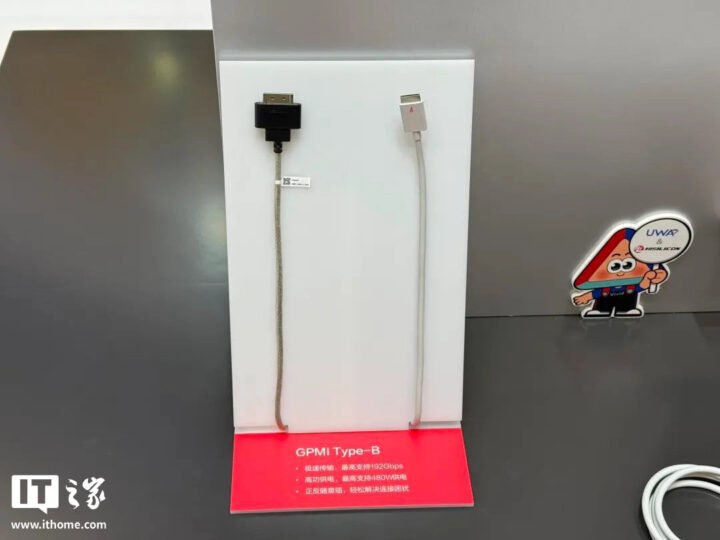
Here’s how GPMI compares to the latest HDMI and DP versions.
| Standard | Speed | Power Delivery |
|---|---|---|
| HDMI 2.1 TMDS | 18 Gbps | N/A |
| HDMI 2.1 FRL | 48 Gbps | N/A |
| DisplayPort 2.1 UHBR20 | 80 Gbps | 240W |
| GPMI Type-C | 96 Gbps | 240W |
| GPMI Type-B | 192 Gbps | 480W |
The best resource I’ve found about the GPMI standard is a white paper shared by Hisilicon. It requires email registration, and it’s only in Chinese, but I’ve translated some of the slides for reference.
The Type-B port looks like a compressed HDMI port, which might be great for laptops and tablets, while the Type-C port appears to be identical to a standard USB-C port. However, I haven’t found the pinout, so it’s unclear whether it’s pin-to-pin compatible, although the diagram below shows USB 2.0 compatibility.
GPMI also implements an alternative to HDCP with ADCP content protection protocol based on SM3 and SM4 “national security algorithms” and much faster than HDMI (200ms vs 2s). The 192 Gbps link can be split into 8 channels, each carrying up to 24 Gbps and configurable as 8+0 (8x Tx @ 192 Gbps, 0x Tx) or alternatives like 7+1 (168/24), 6+2 (144/48), and so on. The standard also supports fast wake-up time, reduced to one quarter of existing standards. The document also mentions an auxiliary link for data transmission of up to 12.5 Mbps, but I’m not sure if it’s related to the Sideband, CableInfo, and Power links shown above, or something else…
GPMI appears to have been unveiled last year at a conference in China according to a post by AOCFiberLink. All 50 companies part of the “Shenzhen 8K UHD Video Industry Cooperation Alliance” appear to be Chinese and include names like HiSilicon, TCL, Konka, Hisense, Skyworth, China Mobile, HIKVision, and others, so it’s unclear whether the GPMI standard will ever gain traction outside of China. HDMI does have a license fee, and it’s unclear whether GPMI will be an open and free standard at this stage.

Jean-Luc started CNX Software in 2010 as a part-time endeavor, before quitting his job as a software engineering manager, and starting to write daily news, and reviews full time later in 2011.
Support CNX Software! Donate via cryptocurrencies, become a Patron on Patreon, or purchase goods on Amazon or Aliexpress


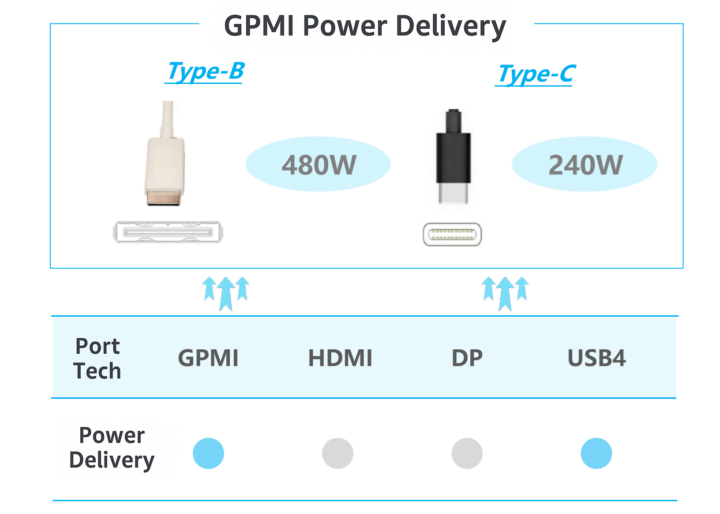
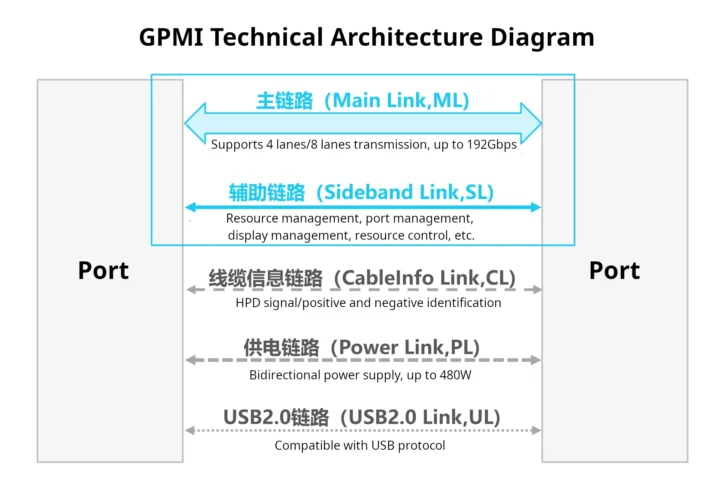
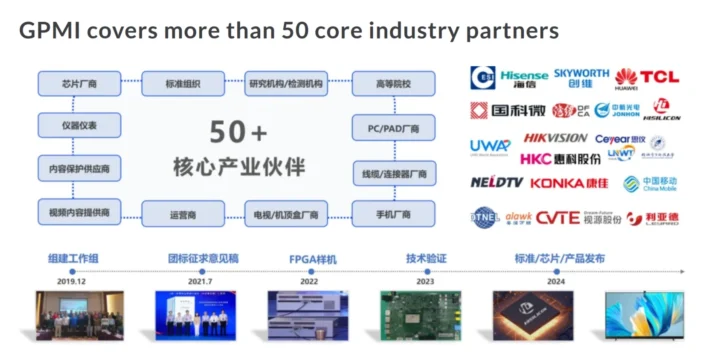
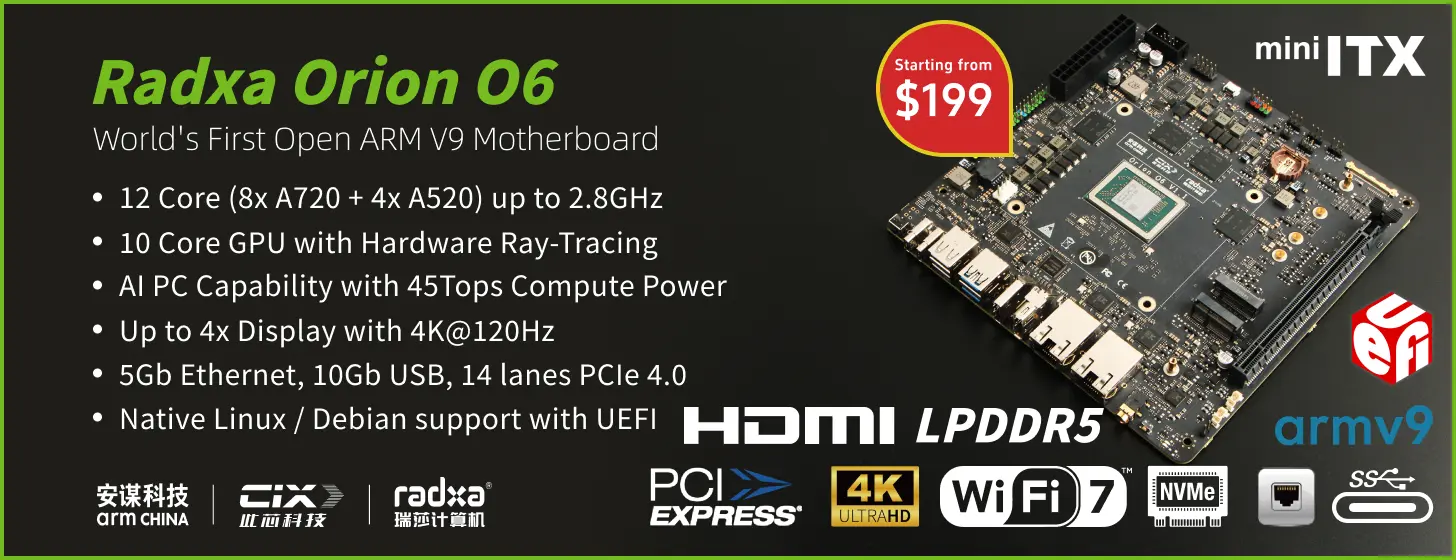


What do we think, 48 Volts, 10 Amps for the Type-B cable?
[ Where’s the power supply?
Is it for the media center, computing unit or for/with/from the peripheral devices? (thx) ]
A compliant TV can power a computer and peripherals, or a computer can power displays and other peripherals attached to it.
I can also see a video wall in the “application scenarios” section of the PDF.
[ Paper Title: 《480W高密度媒体接口电源设计》 (480W High-Density Media Interface Power Design)
Authors: Tsinghua University/Shanghai Jiao Tong UniversityKey Finding: Proposes 12V/40A bus + 48V/10A PoE hybrid for 480W GPMI.Source: CNKI (Search DOI:10.13644/j.cnki.issn2096-9759.2023.04.015)from AI research(, but me could not verify if it’s suitable or the current standard)
from Baidu AI research:
“Voltage for GPMI Power SectionThe GPMI (General Purpose Media Interface) power section supporting up to 480W typically operates at 48V DC, a common voltage for high-power-density systems requiring stable delivery and compatibility with industrial/media equipment5. This aligns with designs integrating advanced power management (e.g., MCU-driven clock/reset configurations) to ensure efficiency and thermal safety”
(thx) ]
Burn, burn, yes, you’re gonna burn!
Yes, exactly !
Imagine a computer with a couple of these “GPMI” ports. With 3/4 of them you’re close from a professional drill as used to work with concrete (1500/2000w).
Ok, bandwidth is impressive, but the announced power delivery is even more insane.
I really wonder if these numbers can be achieved in a long term use (let’s say a 7d/7d h24 huge digital signage).
A 5090 laptop GPU can use up to 175w by itself, before considering CPU, memory, storage, attached peripherals, etc. So 240w USB-C PD isn’t enough to fully power some laptops, but a 480w cable would do the trick.
[ Tom’s hardware mentions a ‘GC-HPWR power connector’ from Asus (with BTF 2.0) for gpu power on mainboards (instead of an additional power cable from the power supply) for up to 1000W(?) (thx) ]
That’s a board to board PCB though, no cable, no typical connector.
https://www.techpowerup.com/331099/asus-second-generation-btf-power-connector-unveiled
[ About the standard size (not too tightly packed, comparable to ATX power supplies) of a ~500W class power supply is around 2.5cm^3 for each Watt and if it’s not only about peak power spikes/requirements, these power supplies are not ‘really’ small (anymore)?
A 570W Usb-C (2x140W Usb PD, 2x100W, etc.) case (with model sketch from inside showing empty space) is about 0.65cm^3/Watt for GaN³ technology (and ~$100-120 with also ~$30 available for a combined output of totalling ~240W).
Seems 240W Usb-C PD ports are getting available these days, finally (previously available was about 180W at most for PD). (thx) ]
[ ~96Gbps is comparable to HDMI2.2 (~96Gbps) and ~16K (15360 x 8640) resolution with 60Hz frequency for display refresh (dynamic?), about 8K (7680 x 4320) 120Hz or 4K (3840 x 2160) 240(/480)Hz. An HDMI (2.1, 2.2?_CES_announced_01/2025) cable for 16K is about $10 for 1-2m. (adapters?) (thx) ]
Any change would take at least 10 years. There are way too many devices on the planet with existing connectivity that will still be used for many years.
And in 5-10 years this technology may also be old by then.
Remember that USB 2.0 type A ports are still very common, despite the USB 3.0 specification being introduced way back in the technological dark ages of 2008.
I can see the cable converter market being potentially profitable though, if there was a concerted cable war.
Keep in mind this is xina only, so the government could mandate this and it would go much faster if that was the case.
I don’t think it would take long at all for the connector to gain traction. In the Chinese market at least.
Workstation laptop or mini PC needs over 240 Watts? Bundle it with the cable, and instructions on how to order a new one on AliExpress. Though it probably needs to pass FCC certification to not be stopped at customs.
Other uses for the cable are more uncertain. The HDCP alternative could be a problem.
The GPMI Type-B is a mistake. They should have made it slightly thicker vertically for greater robustness. Type-C cannot be used in any kind of commercial or industrial setting because it’s too structurally weak due to the round exterior corners. What a waste of an opportunity.
They should have just made a lower profile miniDP connector. VESA does it properly, learn from VESA.
It reminded me of the horrible mini HDMI connector, which ended up being very flimsy due to it being such a slim design.
> too structurally weak due to the round exterior corners
Hmm, I would have guessed a round[ed] (vs rectangular or trapezoidal) shape can actually have more structural rigidity.
Are you sure it’s not just about the thickness of the wall of the USB-C connector?